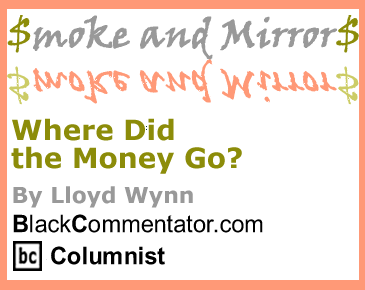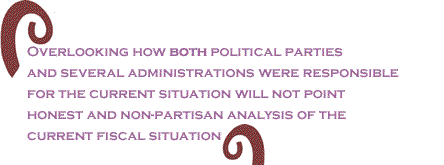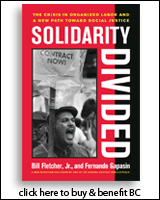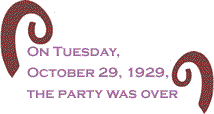
|
|||||||||||||||||||||||

|
|

Custom Search
|
|
 |
|
Since October, 2007, the stock market has lost $8.35 trillion in value, retirement funds have lost over $2 trillion and within the past 2 years, $6 trillion in home equity has vanished. The question many Americans have been asking is where did all that money go? That is a question with merit and will require many different sectors to “come clean”. Otherwise, we will stop at correlation before reaching causation, allowing too many villains to escape their just deserts. The Associated Press put this question to prominent economists, Professors Shiller from Yale and Jorgenson from Harvard. Their response was wealth only existed on paper and the true value is what the market will pay at any given time. The statement may be partially true but it does not answer the question. The individual who is close to retirement and lost $75,000.00 from their pension and now must defer their retirement date, understands the lost was not on paper. The parents who started a college savings plan (529 variety) do not accept this dubious explanation nor do any homeowner whose equity has evaporated over the last 18 months. Let me be clear, the economists and pundits are wrong. The losses and gains are not only on paper. They are as real as your child’s paid tuition, a Lexus, your monthly pension or a Tahitian vacation. Economists have demonstrated they are fallible. Sometimes one’s expertise restricts the ability to look for an explanation beyond the models or paradigms. The answer to the question (where did the money go) can be articulated in a very short paragraph and I intend to share that with you but first I want to continue with what I started last week: a trip down memory lane to visit the origin of credit. The appetite for credit began with US consumers being asked to purchase $17 billion in government bonds to support World War I. In an April 29, 1918, article in the New York Times, a US Treasury official encouraged consumers to buy more bonds and linked the bond participation to patriotism by stating, “[a] hard fact which the nation faces is that Germany, after three years of war, recently floated a loan which averaged one bond to every 10 persons in the empire, and it behooves this country to go well above this average in order to make an impressive demonstration of unity”. In an earlier edition of the NY Times, (May 12, 1917) Jacob Schiff of the NY Federal Reserve, explained the safety and soundness of this investment as well as being an investment vehicle for all Americans - from corporation to individuals, using methods such as buying on installment. Thus, the fear and stigma, of buying on credit was diminished. The American consumer, in general, got their first lesson in investing and borrowing. Prior to this initiative, buying on credit was considered risky and imprudent and those who did buy on credit were often labeled spendthrifts.
The availability of credit became so widespread, individuals were purchasing businesses on credit with only a small down payment. Even more astonishing, by 1927, consumers had begun to purchase stocks on margin with regularity, hoping to cash in on the extraordinary return investors were getting. The Dow Jones Industrial Avg. quadrupled from 1924 through September, 1929 and doubled from early 1928 to September, 1929.
In March of 1929, when the Federal Reserve met to discuss details of regulating the market, sell-offs began and values decreased. If prices decreased by more than 10%, investors were required to borrow additional money to maintain their investment. Banks started to issue margin calls and investors had to provide more cash to pay off their loans for their portfolios or lose their investments. Each investor’s lost triggered additional margin calls because the portfolio was sold at a lower price which created a downward spiral in values. Thus, demand increased for loans to cover the margins which caused interest rates to rise above 15%. National City Bank stepped in to inject about $25 million of credit for potential investors and this eased the interest rates back under double digits. The economic stimulus provided by National City Bank did not restore health to the other sectors of the economy that had begun to show signs of weakening. Consumers had little to no savings as credit was so easily accessible; new customers were hard to find; the demand for consumer goods was declining; factory orders all but disappeared; steel prices declined; cars were not selling which meant many other cottage industries had layoffs and borrowers were defaulting on loans. However, all the other signs that the economy was in trouble did not prevent the market from attracting hordes of investors to make the quick buck. Groucho Marx probably said it best when asked by another gentleman about the stock market, and I paraphrase, the market is never going down. People overseas want American goods. That statement was problematic since the stock market’s performance was not pegged to goods being sold. The market depended upon new investors coming in with cash. In his autobiography, Mr. Marx talked about the quarter of a million dollars he eventually lost.
Stay with us and the question (where did the money go) will be answered here on BlackCommentator.com. BlackCommentator.com Columnist, Lloyd Wynn, was a consultant in the secondary market. Lloyd is the author of Residential Real Estate Finance: From Application Through Settlement. Click here to contact Lloyd Wynn. |
|
Any BlackCommentator.com article may be re-printed so long as it is re-printed in its entirety and full credit given to the author and www.BlackCommentator.com. If the re-print is on the Internet we additionally request a link back to the original piece on our Website. Your comments are always welcome. eMail re-print notice
If you send us an eMail message we may publish all or part of it, unless you tell us it is not for publication. You may also request that we withhold your name. Thank you very much for your readership. |
|
| |
|
| October 16, 2008 Issue 295 |
|
| Executive Editor: Bill Fletcher, Jr. |
| Managing Editor: Nancy Littlefield |
| Publisher: Peter Gamble |
| Est. April 5, 2002 |
Printer Friendly Version
in resizeable plain
text format or pdf
format. |
| Frequently Asked Questions |
 |

|
 |
 |
 |
| |
| |






























 The
next phase of the credit evolution came at the end of World War
I as corporate interests turned their manufacturing might (steel,
plastics and technological innovations) to consumer goods and produced
the likes of refrigerators, air conditioners, toasters, washing
machines, jewelry, clothing and automobiles. The American consumer
had a comfort level with loans from their experience with the Liberty
bonds a few years earlier, thus buying consumer goods on credit
was not entirely foreign or terrifying.
The
next phase of the credit evolution came at the end of World War
I as corporate interests turned their manufacturing might (steel,
plastics and technological innovations) to consumer goods and produced
the likes of refrigerators, air conditioners, toasters, washing
machines, jewelry, clothing and automobiles. The American consumer
had a comfort level with loans from their experience with the Liberty
bonds a few years earlier, thus buying consumer goods on credit
was not entirely foreign or terrifying. Approximately
$6 billion was used by consumers to buy on margin (credit) in 1928.
The down payment was as little as 10%. The stock market was unregulated
and manipulation of stock was not uncommon. There were many stories
of groups making millions in a week through stock manipulation,
which made the market more attractive. RCA, for example, was the
Google prior to the crash. In 1928 RCA went from $85 to $420 which
represented over a 3000% return on investment. The public went into
an investing frenzy.
Approximately
$6 billion was used by consumers to buy on margin (credit) in 1928.
The down payment was as little as 10%. The stock market was unregulated
and manipulation of stock was not uncommon. There were many stories
of groups making millions in a week through stock manipulation,
which made the market more attractive. RCA, for example, was the
Google prior to the crash. In 1928 RCA went from $85 to $420 which
represented over a 3000% return on investment. The public went into
an investing frenzy.





